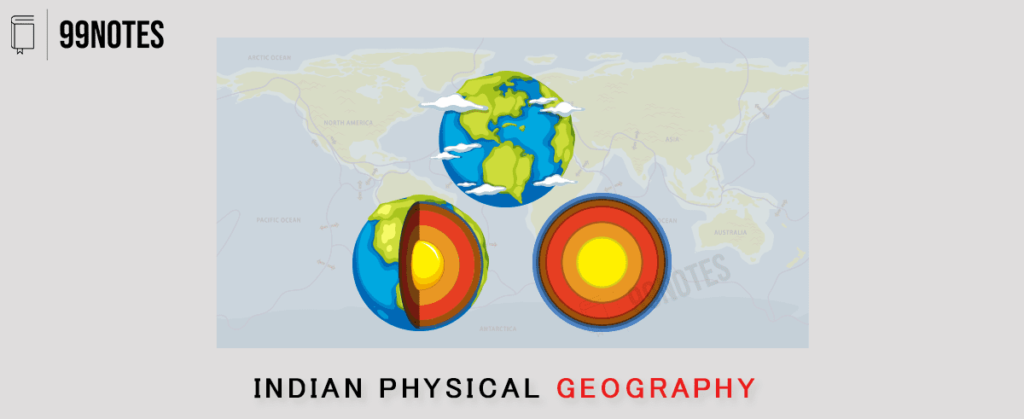
Indian Physical Geography Notes for UPSC Free Download
Physical Geography of India
Indian physical geography is an important topic for the UPSC CSE, as it provides insight into the natural resources, hazards, and environmental issues that are relevant to the country.
A basic understanding of India’s physical features and processes can help you to better understand and analyze the issues that you will encounter in the civil service exam.
Some specific ways in which Indian physical geography may be relevant to the UPSC CSE include:
- Natural resources: India is home to a wide range of natural resources, including minerals, timber, and agricultural land. Understanding the distribution and importance of these resources can help you to understand the economic and environmental issues that are relevant to different parts of the country.
- Hazards: India is also subject to a number of natural hazards, including earthquakes, landslides, and floods. Understanding the location and frequency of these hazards can help you to understand the risks that different regions face and the measures that can be taken to mitigate these risks.
- Environmental issues: India is faced with a number of environmental challenges, including air and water pollution, the loss of biodiversity, and the impacts of climate change. A basic understanding of these issues can help you to understand the measures that are being taken to address these challenges and the potential consequences of inaction.
India is a diverse and geographically varied country, with a wide range of physical features and processes that shape its landscape and climate.
One of the main physical features of India is its topography, which includes a range of landforms such as mountains, plateaus, valleys, and coastlines.
The country is home to several mountain ranges, including the Himalayas in the north, the Western Ghats in the west, and the Eastern Ghats in the east. These mountain ranges are a significant source of water for the country, as they provide the headwaters for many of India’s major rivers. The Himalayas also serve as a natural barrier that separates India from the rest of Asia, and they are home to a number of unique plant and animal species.
In addition to mountains, India is also home to several plateaus, including the Deccan Plateau in the south and the Tibetan Plateau in the north. These plateaus are generally higher in elevation than the surrounding land and are characterized by flat or gently sloping terrain. They are also important sources of natural resources, such as minerals and timber.
The country is also home to a number of rivers and valleys, including the Ganges, Brahmaputra, and Indus rivers. These rivers are important sources of water and transportation, and they also support a wide range of agricultural and industrial activities. The valleys that these rivers flow through are often fertile and densely populated, and they have played a central role in the development of Indian civilization.
India’s coastlines are also an important physical feature, as they provide access to the Arabian Sea, the Bay of Bengal, and the Indian Ocean. The country’s long coastline has played a significant role in its history, as it has facilitated trade and cultural exchange with other countries. The coastlines are also home to a number of important ports and cities, including Mumbai, Kolkata, and Chennai.
The climate of India is varied, as the country is influenced by a number of different factors, including its location in the tropics, the presence of mountain ranges, and the influence of monsoons.
The country generally has a hot and humid climate, with temperatures ranging from the high 20s to the low 40s Celsius.
There are three main seasons in India: the hot and dry summer season, the monsoon season, and the cool and dry winter season. The monsoon season, which occurs from June to September, is characterized by heavy rainfall that is brought by the southwest monsoon winds. The monsoon season is an important source of water for the country, as it provides the majority of the annual precipitation.
In addition to its physical features and climate, India is also home to a wide range of natural resources, including minerals, timber, and agricultural land.
The country is a major producer of a number of minerals, including coal, iron ore, and bauxite. It is also home to a number of forests, including the Sundarbans in the east and the Western Ghats in the west, which are home to a wide range of plant and animal species. Finally, India has a large agricultural sector, and it is a major producer of a number of crops, including rice, wheat, sugarcane, and cotton.
However, India is also faced with a number of environmental challenges, including air and water pollution, the loss of biodiversity, and the impacts of climate change.
The country has a high rate of air pollution, particularly in its major cities, which is caused by a range of factors, including industrial emissions, vehicle
Overall, studying Indian physical geography can provide you with a broad understanding of the natural features and processes that shape the country and the ways in which these features and processes affect human society and the environment.
This knowledge can be useful in helping you to analyze and understand the issues that you will encounter in the UPSC CSE.

